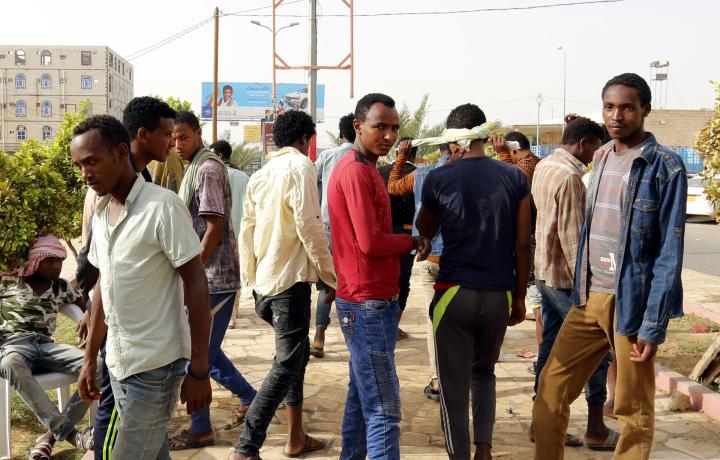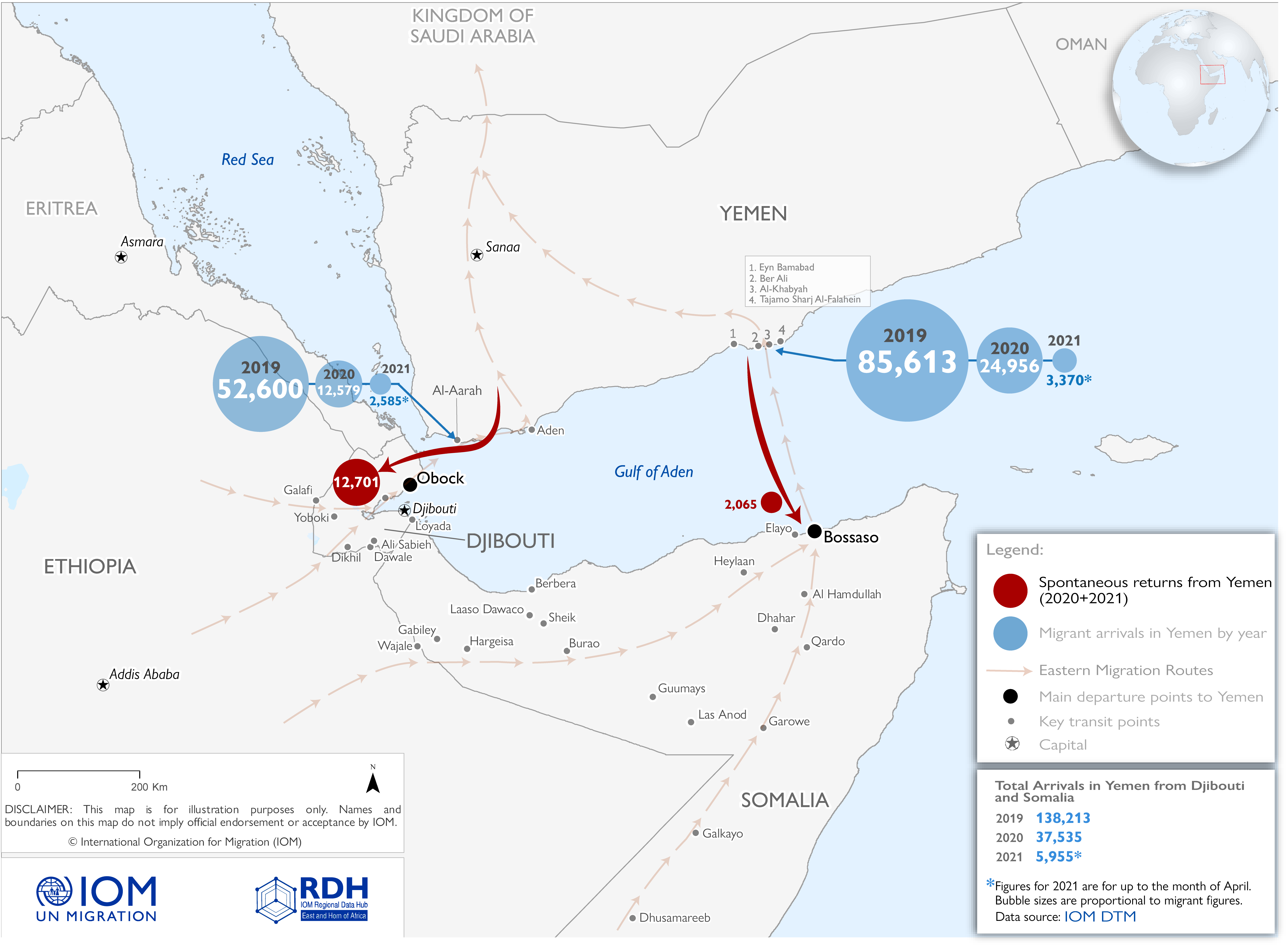ISS TODAY
Horn of Africa proving to be a dangerous road home for migrants

Covid-19 is a key factor forcing migrants travelling to Saudi Arabia to make risky journeys home from Yemen.
First published by ISS Today
For a long time, the Eastern Route between the Gulf states via Yemen and the Horn of Africa has been used mainly by Yemenis fleeing the war in their country. Since the first half of 2020, however, African migrants in Yemen have been using this route — each paying smugglers $300 — to get home to the Horn via Djibouti.
Migrants are returning for three main reasons: their inability to find work in Yemen, increased human rights abuses in Yemen, and the closure of the Yemen-Saudi Arabia border.
Stephanie Daviot, the United Nations’ International Organization for Migration (IOM) Djibouti representative, said in October 2020 that “Migrants are arriving in Djibouti in large numbers from Yemen” and many more might be waiting to make similar trips. Over 32,000 are stranded in Yemen without access to shelter, water, food or health services.
Between May 2020 and April 2021, 12,701 African migrants returned from Yemen to Djibouti, landing on the coast of Obock, according to an upcoming IOM report on the impact of Covid-19 on migrants using the Eastern Route. Since the first half of 2020, 2,065 returned to Somalia. Most of the migrants likely used smugglers to get them home.
The return of Horn of Africa migrants aided by smugglers is a new trend along the Eastern Route. This was the busiest maritime migration route in 2019, used by over 138,000 migrants from the Horn to reach Yemen.
The route involves three legs. The first is from the migrants’ countries of origin to Obock in Djibouti or Bosaso in Somalia. The second involves the sea journey between Obock or Bosaso and Yemen, and the border crossing point from Yemen to the Gulf States — mainly Saudi Arabia. The return route follows the same stops but in reverse. Most migrants who have used the Eastern Route are Ethiopians, and some are Somalis.
 A map showing migrant arrivals and returns from Yemen. (Graphic: Provided by ISS Today)
A map showing migrant arrivals and returns from Yemen. (Graphic: Provided by ISS Today)
Yemen’s economy has been badly affected by Covid-19, limiting citizens’ already meagre job opportunities and dims those of migrants. In a November 2020 study, 49% of Yemeni respondents indicated that a family breadwinner had lost their job.
The ongoing war in the country means that two out of every three Yemenis (20.7 million people) require some form of humanitarian and protection assistance. For migrants in Yemen, Covid-19-related movement restrictions have limited their access to services and income. Some who were previously employed have lost their jobs.
Increased human rights abuses and violence in Yemen is another reason why migrants are forced to return home. Reports are growing about migrants’ detention under deplorable conditions, including widespread torture in Yemen and Saudi Arabia. Migrants experience discrimination and xenophobia, including being labelled as carriers of Covid-19.
The closure of the Yemen-Saudi Arabia border since April 2020 due to the pandemic (except for commercial cargo) has also dashed migrants’ hopes of reaching Saudi Arabia to earn a living. Working there would enable them to pay the debt that financed their journey and send remittances home to their families.
And so thousands of migrants have been stranded along the Eastern Route, triggering an appeal from the IOM in March for $99-million to help them return home. Over 6,000 of the 32,000 migrants stuck in Yemen have already registered with the IOM for the Voluntary Humanitarian Return programme. Over 200 have returned to Ethiopia this year with the help of the IOM.
The factors outlined above leave migrants with few options to get home. They mainly risk using smugglers for the sea crossing back to Djibouti and Somalia without any guarantee of safe arrival. Smugglers use small, shabby and overcrowded boats that can easily capsize. Occasionally some throw migrants overboard to reduce the weight.
In the most recent boat tragedy this year, on 12 April, 44 migrants died off the coast of Djibouti when their boat capsized on their way back from Yemen. Among them were 16 children. In a similar incident in the same location, at least eight migrants died and 12 went missing in October 2020.
The fact that most migrants consider returning from Yemen to their countries of origin via Djibouti, which is a less preferred route, shows their level of desperation. The journey passes through areas at the centre of fighting between the rebels who control Yemen’s north and the internationally recognised government that runs the south. This return route puts migrants in danger, exposing them to the same extreme poverty, conflict and other socio-economic ills they had hoped to leave behind.
These problems can be addressed only through a coordinated response by countries of origin, transit and destination, and the relevant regional and international organisations. The IOM is calling for an interstate dialogue among countries of origin and transit in the Horn of Africa and destination countries in the Arabian Peninsula.
Mohammed Abdiker, IOM’s regional director for the East and Horn of Africa, emphasised the importance of such a dialogue. He told ISS Today, “We need effective policies to make migration along the eastern corridor safer, which can be achieved only through a strong route-based collaboration among governments and other actors supported and informed by a strong evidence base.”
If properly led and supported by all concerned countries, such dialogue could facilitate safe, orderly, regular and humane migration. This would render the dangerous smuggling services a less preferred option for migrants. DM
Tsion Tadesse Abebe, Senior Researcher, Migration, ISS and Mohamed Daghar, ENACT Regional Organised Crime Observatory Coordinator — Eastern Africa, ISS Nairobi.
This article is part of a joint Institute for Security Studies (ISS)-International Organisation for Migration (IOM) research project on the Eastern Route.

















 Become an Insider
Become an Insider
Comments - Please login in order to comment.